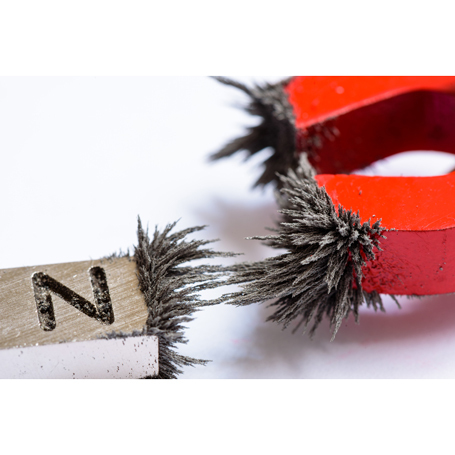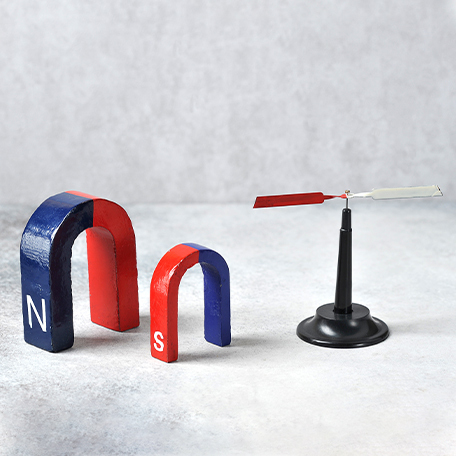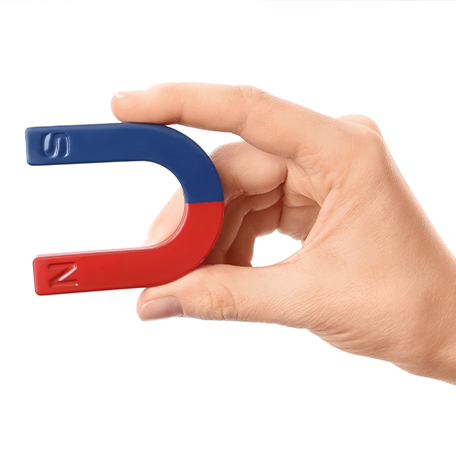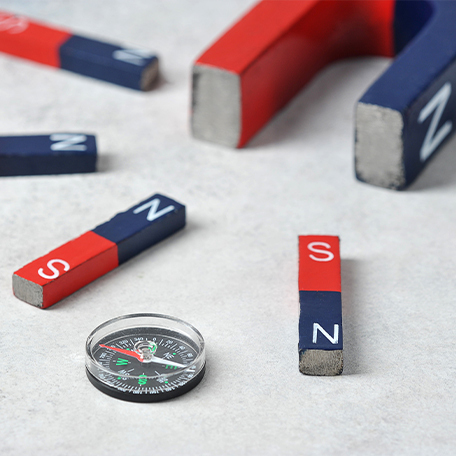
Horseshoe magnet - the helper for school and at home
A young man from Düsseldorf found out painfully that magnets can do more than just attach shopping lists to the refrigerator door: In order to hang his bike from the ceiling over the winter, he had ordered two so-called super magnets on the Internet. When unpacking the heavy metal plates from separate packages, however, the amateur athlete underestimated the enormous forces of attraction: His hand was squeezed between the magnets striving towards each other like in a vise.
Finally, the fire brigade had to move in, and they freed the man from the magnetic clamp using physical strength, a rubber mallet, and wooden wedges. It is not without reason that experts recommend finding out about the possibilities and risks before handling magnets. Decorative horseshoe magnets seem rather harmless in this context.
Here you can find out why these specimens are particularly suitable for interesting experiments and where you can still use them in everyday life.
How does a horseshoe magnet work?
 In contrast to an electromagnet, a horseshoe magnet is what is known as a permanent magnet. Due to its material composition, it constantly generates a magnetic field within itself and in its immediate vicinity. Like every magnet in the world, a horseshoe magnet has two magnetic poles. Both its north and south poles exert strong gravitational pulls on bodies made of ferromagnetic materials such as iron, cobalt, and nickel. This force is also known as the Lorentz force. The exact definition of the Lorentz force is: The Lorentz force is the force that acts on individual moving charge carriers in a magnetic field (Lorentz force).
In contrast to an electromagnet, a horseshoe magnet is what is known as a permanent magnet. Due to its material composition, it constantly generates a magnetic field within itself and in its immediate vicinity. Like every magnet in the world, a horseshoe magnet has two magnetic poles. Both its north and south poles exert strong gravitational pulls on bodies made of ferromagnetic materials such as iron, cobalt, and nickel. This force is also known as the Lorentz force. The exact definition of the Lorentz force is: The Lorentz force is the force that acts on individual moving charge carriers in a magnetic field (Lorentz force).
This phenomenon is due to the atomic structure of metals. Due to the spin, the movement of the electrons around the atomic nucleus, each iron particle acquires the properties of a tiny electromagnet. Each atom has its own north and south poles.
When iron encounters a magnet, its elementary components align with the pole counterparts of the magnet. So, the north pole of each iron atom moves towards the south pole of the magnet and vice versa. The effect is visible and noticeable in the form of magnetic attraction on these bodies.
What are magnetic field lines?
The direction in which the forces of a magnetic field (Lorentz force) run is illustrated by the field lines on schematic drawings that many people are familiar with from physics lessons. In the direction of their arrows, they symbolize where the north pole of an imaginary iron particle would move along the magnet.
What characterizes the magnetic field of a horseshoe magnet?
Compared to the magnetic field of a bar magnet, the field lines in the vicinity of a horseshoe magnet (due to its bridge shape) draw a much more complex picture. On the one hand, they move from the inside of the North Pole directly to the opposite South Pole and generate such a homogeneous magnetic field that no other shaped magnet has. On the other hand, from the outside of the North Pole, the field lines run in arcs around the horseshoe towards the outside of the South Pole. They never overlap. Stronger areas of the magnetic field are indicated in the illustration by a higher density of field lines. This also applies to bridge-shaped magnets. Do you need corresponding strong horseshoe magnets? You can find suitable specimens in our school magnets category!
The horseshoe magnet: Experiments for school and at home
Horseshoe magnets are predestined for physics. With their help, the basic laws of magnetism can be illustrated in a playful way. 
Horseshoe magnet: 1st experiment: Making magnetic field lines visible
In addition to the horseshoe magnet, for this experiment you will need fine iron filings, such as those produced when filing metal objects. The experiment works as follows:
- Step 1: Distribute iron filings
Spread the shavings on a smooth surface, e.g., a coated tabletop or a sheet of paper.
- Step 2: Bring the horseshoe magnet into contact with the filings
If you then place a horseshoe magnet in the center of the shavings, the iron particles align themselves along the magnetic field lines due to the polarity of their atoms. In this way, the course of the field lines can be made visible and the extent of the magnetic field can be measured.
Large horseshoe magnets, whose poles are color-coded, are particularly suitable for such an experiment.
Horseshoe magnet: 2nd experiment: Magnetize objects
Nails, screws, paperclips, and other objects can be turned into magnets themselves with the help of a horseshoe magnet (in the shape of a bridge). The principle behind it is also based on the magnetic alignment of the contained iron components. To do this, simply follow the steps below:
- Step 1: Strike the horseshoe evenly along metal objects
For example, strike a horseshoe magnet from head to tip of a nail repeatedly, regularly aligning the poles of its atoms in one direction. As a result, a magnetic north and south pole are formed on the nail. You can easily attract smaller and lighter metal objects such as a paper clip with this newly created magnet. However, if you drop the nail on the ground, the alignment of the iron components will become disordered again, so that the magnetic force of the object disappears.
- Step 2: Demonstrate the creation of new magnets with their own north and south poles by cutting them up
Magnetized pieces of wire can also be used to simulate what happens when a magnet breaks: Cut the magnetized wire in half – between the north and south poles of the magnet, so to speak – and two new magnets are created, each with their own poles. There is no single pole magnet in the world.
Horseshoe magnet: 3rd experiment: Build a compass

Children who are enthusiastic about outdoor activities and playful survival training love this experiment. Proceed as follows:
- Step 1: Have supplies ready
You will need a plastic bowl filled with water, a cork, a needle, and a horseshoe magnet. - Step 2: Magnetize the needle
Swipe the north pole of the horseshoe magnet from the eye of the needle to the tip at least twenty times. It is important to pull the magnet away from the needle once you have reached the tip and to put it back on again at the top end.
In this way, the elementary particles of the needle metal align themselves regularly. - Step 3: Fix the needle on the cork disk and place it on the water surface
Fixed on a disk of the cork, put the needle on the water surface. Due to the earth's magnetic field, it automatically aligns itself in a north-south direction.
But be careful:Place the horseshoe magnet used in construction out of reach of the swimming compass so that its own magnetic field does not affect the needle.
The Horseshoe Magnet: Frequently Asked Questions
We have collected the most common questions asked about horseshoe magnets.
Where does the term "magnet" come from?
The name of all artificial magnets derives from the naturally magnetic mineral magnetite. This in turn is said to have originally been discovered in the Greek region of Magnesia. The version of the ancient historian Pliny is different: According to him, a shepherd named Magnes in the Turkish Ida Mountains once noticed that the nails of his shoes and the metal tip of his walking stick stuck to the magnetite-containing soil.
Which is stronger - A horseshoe magnet or a rodmagnet?
If both are the same size, a horseshoe magnet will have a higher holding force or adhesion than a rodmagnet. In contrast to the rodmagnet, which can never bring both poles into contact with a metal part at the same time, a horseshoe magnet acts on its metallic counterpart due to its bridge shape with north and south poles together. In addition, the absolute size of a magnet is decisive for its adhesive force.
Finally, the strength of the magnetic effect depends not least on the material of the magnet: So-called ferrite magnets exert relatively weak forces of attraction and can only be used up to an operating temperature of 250 °C. Magnets made of aluminium, nickel, and cobalt (AlNiCo) are stronger and can be used up to an operating temperature of 500 °C. The material is easy to process, so you can get AlNiCo magnets in many conceivable shapes - including horseshoe magnets. Magnets made of the rare earth neodymium in combination with iron and boron are often referred to as "super magnets" due to their strong adhesive force or magnetic forces. However, because neodymium is brittle, they do not come in the horseshoe shape. Accordingly, there are no neodymium horseshoe magnets.
What is the use of a horseshoe magnet?
Permanent magnets are used by industry in the field of mechanics, electronics and electromechanics, for example in:
- Electric engines
- Bicycle dynamos
- Microwave ovens
- modern wind turbines
In the past, horseshoe magnets were often used as field magnets in radio speakers. With large dimensions, they can lift scrap and metal parts or dangerous goods or help to sort out metal objects in waste separation. In schools and private homes, horseshoe magnets (bridge shape) enable vivid experiments, can be used for handicrafts and DIY or to collect metallic bodies and small parts from chaotic desk drawers, toolboxes or sewing boxes.
Where can I get nice and big horseshoe magnets?
At magnet-shop.netyou can get horseshoe magnets made of ferrite as well as AlNicCo - the latter naturally exerting the stronger magnetic force. Large specimens, whose poles are colour-coded, are particularly suitable for the learning experiments described.
Of course, we also have super magnets or neodymium magnets for you in the magnet shop.
What does geographic and magnetic north pole mean?
The rotational movements of the earth's liquid core create a huge magnetic field in and around our planet, comparable to that of a large rodmagnet. Any magnet on earth aligns itself with the course of this field if you hang it loosely on a piece of string, for example. However, the geographical north pole of our planet, which represents the imaginary northern crossing point of the earth's rotation axis, is not congruent with the magnetic pole of the Arctic. The magnetic pole is a few kilometers from the geographic pole and moves up to 80 kilometers a day, depending on solar activity. Confusingly, the magnetic pole in the Arctic is a south magnetic pole. This naming has historical reasons. When humans first discovered that a pole of a magnet oriented north, the convention of calling the corresponding side of the magnet the "North Pole" arose. Only later did it become clear that opposite poles attract and that the magnetic pole in the north of the earth must therefore be a magnetic south pole. To avoid confusion, science today refers to the "Arctic and Antarctic magnetic poles".
Conclusion: Horseshoe magnets are ideal for school lessons
Magnetism is ideal for getting children interested in science and for demonstrating the Lorentz force on metallic bodies, for example. Materials that attract each other as if by magic and align themselves with invisible field lines arouse curiosity about the physical laws in the background. While young researchers like to experiment, the older ones are particularly fascinated by the practical use of magnets - be it in DIY, salvaging dangerous goods or elegant clasps on designer handbags or gold jewellery. Take advantage of the advantages and order the right horseshoe magnet here!
Our matching strong neodymium magnets can be found in the corresponding category.
 Thousands of products in stock
Thousands of products in stock


